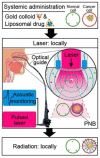Insights into Nanomedicine for Head and Neck Cancer Diagnosis and Treatment
- PMID: 35329542
- PMCID: PMC8951645
- DOI: 10.3390/ma15062086
Insights into Nanomedicine for Head and Neck Cancer Diagnosis and Treatment
Abstract
Head and neck cancers rank sixth among the most common cancers today, and the survival rate has remained virtually unchanged over the past 25 years, due to late diagnosis and ineffective treatments. They have two main risk factors, tobacco and alcohol, and human papillomavirus infection is a secondary risk factor. These cancers affect areas of the body that are fundamental for the five senses. Therefore, it is necessary to treat them effectively and non-invasively as early as possible, in order to do not compromise vital functions, which is not always possible with conventional treatments (chemotherapy or radiotherapy). In this sense, nanomedicine plays a key role in the treatment and diagnosis of head and neck cancers. Nanomedicine involves using nanocarriers to deliver drugs to sites of action and reducing the necessary doses and possible side effects. The main purpose of this review is to give an overview of the applications of nanocarrier systems to the diagnosis and treatment of head and neck cancer. Herein, several types of delivery strategies, radiation enhancement, inside-out hyperthermia, and theragnostic approaches are addressed.
Keywords: drug delivery; head and neck cancer; hyperthermia; nanocarrier; nanomedicine; target therapeutic; theragnostic.
Conflict of interest statement
The authors declare no conflict of interest.
Figures









Similar articles
-
INGN 201: Ad-p53, Ad5CMV-p53, adenoviral p53, p53 gene therapy--introgen, RPR/INGN 201.Drugs R D. 2007;8(3):176-87. doi: 10.2165/00126839-200708030-00005. Drugs R D. 2007. PMID: 17472413 Review.
-
Insights into Nanomedicine for Immunotherapeutics in Squamous Cell Carcinoma of the head and neck.Int J Biol Sci. 2020 Jul 19;16(14):2506-2517. doi: 10.7150/ijbs.47068. eCollection 2020. Int J Biol Sci. 2020. PMID: 32792853 Free PMC article. Review.
-
Local hyperthermia in head and neck cancer: mechanism, application and advance.Oncotarget. 2016 Aug 30;7(35):57367-57378. doi: 10.18632/oncotarget.10350. Oncotarget. 2016. PMID: 27384678 Free PMC article. Review.
-
Advances in nanomedicine for head and neck cancer.Front Biosci (Landmark Ed). 2014 Jan 1;19(5):783-8. doi: 10.2741/4245. Front Biosci (Landmark Ed). 2014. PMID: 24389222 Review.
-
Emergence in protein derived nanomedicine as anticancer therapeutics: More than a tour de force.Semin Cancer Biol. 2021 Feb;69:77-90. doi: 10.1016/j.semcancer.2019.11.012. Epub 2020 Jan 18. Semin Cancer Biol. 2021. PMID: 31962173 Review.
Cited by
-
Radiopharmaceuticals: navigating the frontier of precision medicine and therapeutic innovation.Eur J Med Res. 2024 Jan 5;29(1):26. doi: 10.1186/s40001-023-01627-0. Eur J Med Res. 2024. PMID: 38183131 Free PMC article. Review.
-
A Review of Advanced Multifunctional Magnetic Nanostructures for Cancer Diagnosis and Therapy Integrated into an Artificial Intelligence Approach.Pharmaceutics. 2023 Mar 7;15(3):868. doi: 10.3390/pharmaceutics15030868. Pharmaceutics. 2023. PMID: 36986729 Free PMC article. Review.
-
Revolutionizing head and neck squamous cell carcinoma treatment with nanomedicine in the era of immunotherapy.Front Immunol. 2024 Nov 29;15:1453753. doi: 10.3389/fimmu.2024.1453753. eCollection 2024. Front Immunol. 2024. PMID: 39676875 Free PMC article. Review.
-
New insights of cerium oxide nanoparticles in head and neck cancer treatment.Sci Rep. 2025 Mar 5;15(1):7665. doi: 10.1038/s41598-025-85228-3. Sci Rep. 2025. PMID: 40044797 Free PMC article.
-
Advances in Pancreatic Cancer Treatment by Nano-Based Drug Delivery Systems.Pharmaceutics. 2023 Sep 21;15(9):2363. doi: 10.3390/pharmaceutics15092363. Pharmaceutics. 2023. PMID: 37765331 Free PMC article. Review.
References
-
- World Health Organization (WHO)—Cancer Control Programme. [(accessed on 20 December 2021)]. Available online: http://www.who.int/cancer/en/
Publication types
Grants and funding
LinkOut - more resources
Full Text Sources
Miscellaneous

